Trains in Spain – Rail Passes, Buying Tickets and How To Plan Your Train Travel in Spain COMPLETE GUIDE 2022
You are probably considering traveling in Spain by train. But you still have many questions and are unsure whether this is the option that best suits your needs. Will you be better off buying point-to-point tickets or a rail pass? If it’s a rail pass, which one is better?
Here’s everything you need to know about Trains in Spain – Rail Passes, Buying Tickets and How To Plan Your Train Travel in Spain
A great trip starts with good planning, so keep reading for some helpful tips. Whether you are traveling alone, with your family or with a large group, you will learn how to get the best price and book your reservation.
Below is a list of the most frequent questions you will face while planning your train trip.
You can find more information, including a step-a-step tutorial of the purchasing process, reading a complete guide to train travel in Spain.
Should I Travel by Train in Spain or Rent a Car?
Deciding between taking the train and renting a car is one of your biggest pre-trip decisions. Take these variables into account when determining whether your Spanish experience might be better by car or train:
- Geographical range. Trains are better if you are covering a wide area. While Spain could be perceived as of small size by Americans, Canadians, and Australians, you would surely prefer the train if you plan to travel across the country. This is particularly the case for an itinerary including Barcelona, Madrid, and part of Andalucía.
- Rail coverage. Fortunately, Train travel in Spain is extremely easy, comfortable, and safe. There are more than 14,000 km (8,700 mi) of railways. In other words, the network serves almost village in the country.
- Urban vs. rural. This is an important decision. Do you plan to spend most of the time in big cities or do prefer to explore faraway little towns? A car is a pointless hassle in most Spanish cities, but it can be really helpful in the countryside where train communications are less frequent.
- The number of travelers. How many people will be traveling with you? A car is usually the cheaper option when shared with more than 2 people so it may be a good option if you are traveling on a budget. But don’t forget to add the parking costs and the extra fee the rental car company will charge you if you return the car in a different city.
- Luggage. Are you bad at packing light? Then your best option is a car. Renfe, the Spanish railway operator, lets you carry up to three pieces of luggage that may not exceed 25 kg without any chance to buy extra baggage allowance.
- Kids in tow. Car travel is more flexible, but trains give kids room to move around. Travel times will also be considerably lower so your patience won’t be challenged by their usual “when are we getting there?” question. In addition to this, did you know that children younger than 4 can travel for free?
Should I Get A Rail Pass in Spain?
What’s the difference between a point-to-point ticket and a rail pass? And should I get a Spain rail pass?
Point-to-point tickets are tickets bought individually to get you from Point A to Point B. It’s easier to buy these online, which can be handy if you need to secure an advance booking for a certain train.
On the other hand, a rail pass covers train travel in one or more countries for a certain number of days. This pass can allow traveling either for a continuous span of days or for a number of days spread over a wider period of time. Renfe has several passes, the most popular being the Spain Pass.
Most rail passes available to non-Spaniards can only be bought outside Spain. Therefore, sketch out your itinerary before your trip. Then, answer the following questions:
- How many days do you expect to take the train?
- How many countries or regions will you be visiting by train?
- Roughly how much would your point-to-point tickets cost?
- How does your point-to-point ticket cost compare to the price of a pass?
What Rail Pass Should I get for Spain?
Compare passes thoroughly to find the best fit for your itinerary and style of travel. The range of options may look intimidating, but you only need to decide which countries you intend to travel in and for how many days.
Travel in Spain only: Buy the Renfe Spain Pass
You can choose a pass of 4, 6, 8, 10 or 12 journeys with two class modalities: Business/Club or Tourist. It is valid for all AVE, Long Distance and Medium Distance trains (excluding couchettes).
This pass is active for 6 months as from the date of issue and is valid for 1 month as from the date on which it is first validated for a journey.
Travel in Spain and other European countries: Buy the Eurail Pass (for non-European residents)
A Eurail Pass can only be used by non-European residents, living outside of Europe for at least 6 months. Your Eurail pass will serve as your ticket on most trains. However, keep in mind that many European high-speed and night trains require bookings.
There are 4 types of passes:
- Global Pass. You can travel up to 24 countries.
- Select Pass. It allows you to travel around 4 bordering countries of your choice.
- Regional Pass. Combine two countries.
- One country Pass.
If you’re still unsure which Eurail pass is best for you, see:
- Eurail or InterRail?
- Why trains are the best way to travel in Europe
- How to get cheap train tickets in Europe podcast
- How to choose the right Eurail pass
You will travel in Spain and other European countries: Buy the InterRail Pass (European residents)
An InterRail pass can only be used by European residents, living in Europe for at least 6 months. There are two types of passes: the Global Pass and the One Country Pass. Your choice will depend on the countries you want to visit.
- If you want to see as much of Europe as possible, I recommend the InterRail Global Pass, which is valid for train travel in 30 European countries.
- If you plan to visit a single country, you can buy an InterRail One Country Pass instead.
- If you intend to visit 2 or 3 countries, it’s better to buy several One Country Passes.
If you’re still unsure which Eurail pass is best for you, see:
- Eurail or InterRail?
- Why trains are the best way to travel in Europe
- How to get cheap train tickets in Europe podcast
Buying Spanish Train Tickets
You have three main options for buying point-to-point tickets:
- In person at Europe’s train stations (and at some European travel agencies),
- Through a US-based retailer before leaving home, and
- Through Renfe’s website which is the option that I always recommend.
Unfortunately, the Spanish railway site is sometimes not translated into English and has been unreliable not allowing US credit cardholders to purchase their tickets online.
If this is your case, make sure you contact first your bank so that you can use your card on international websites. You can always use a third party if you still can do it yourself although you will have to pay an additional fee, at least you will have your tickets!
The process is very straightforward and it will only take you a few minutes if you already know when and where you would like to travel.
This is a short summary of the tariffs you could find on Renfe’s website:
- P (Promo). It is a promotional ticket with a cheaper tariff, up to a 70% discount on the general fare.
- P+ (Promo+). It is a promotional ticket with a cheaper tariff, up to a 65% discount on the general fare.
- F (Flexible). It is a more expensive ticket allowing you to change at no cost.
- Tarifa Ida y Vuelta (Return ticket, icon with the two arrows). This is a cheaper rate than the Flexible one, offering a 20% on both the outward and return journeys.
- 4M (Mesa or Table for 4). This tariff is ideal if you are traveling with your family or a party of four.
What Are You Waiting For? Book Your Tickets!
Taking the train allows you to travel stress free – have a drink, read a book or enjoy the landscape! Moreover, you will arrive right at the city center avoiding annoying transfers. Just drop off your luggage and enjoy your holiday right away.
But the best advantage of train travel is that you don’t need to check-in hours in advance, or waste time waiting in line. The best way to make the most out of your time is to plan ahead, organize your itinerary and book your tickets ahead.
Once you are in Spain all you will have to do is have fun and discover this amazing country!
More Spain Travel Stories:
- Spain travel
- Top ten things to do in Spain (podcast)
- What to eat (and drink!) in Madrid
- A Coruna Itinerary: The Best Day in A Coruña, Spain (travel podcast)
- Rail Passes, Buying Tickets and How To Plan Your Train Travel in Spain COMPLETE GUIDE 2022
- Why you shouldn’t move to Spain

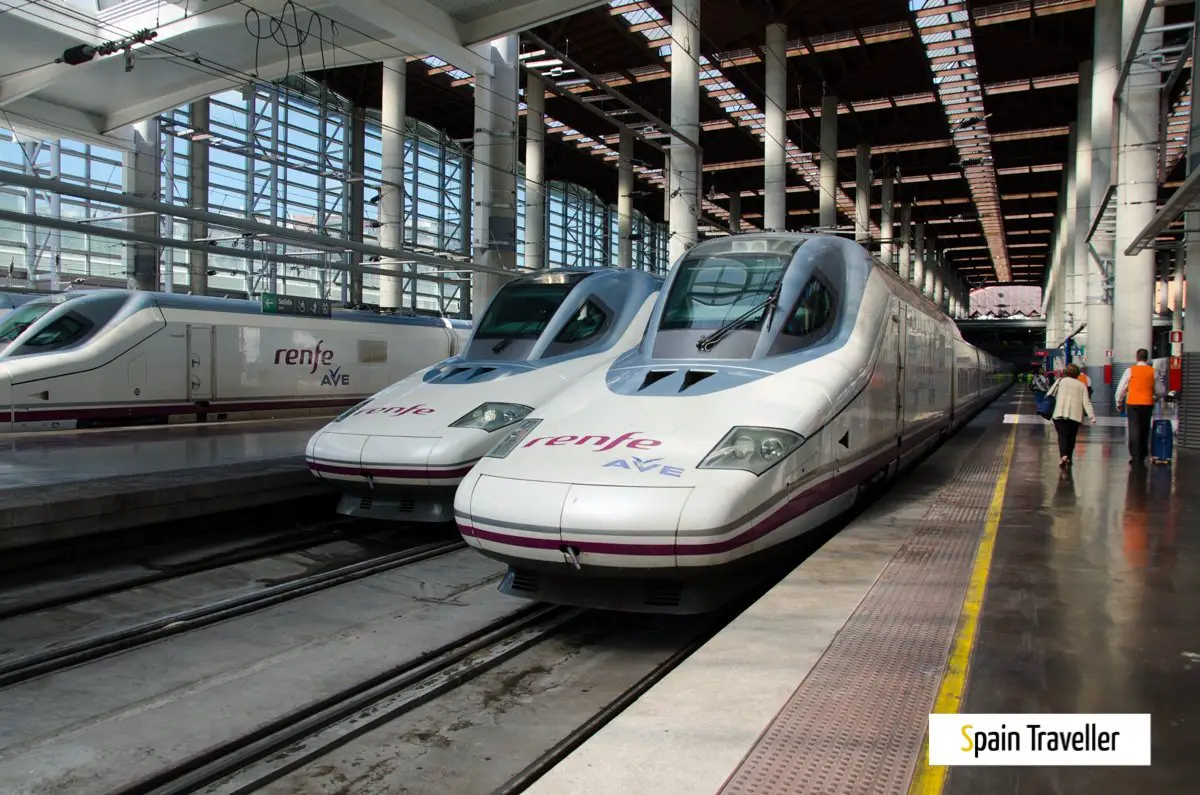
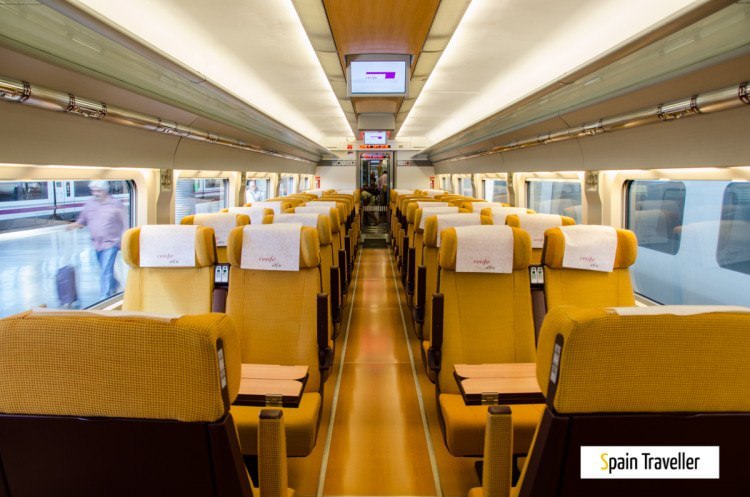
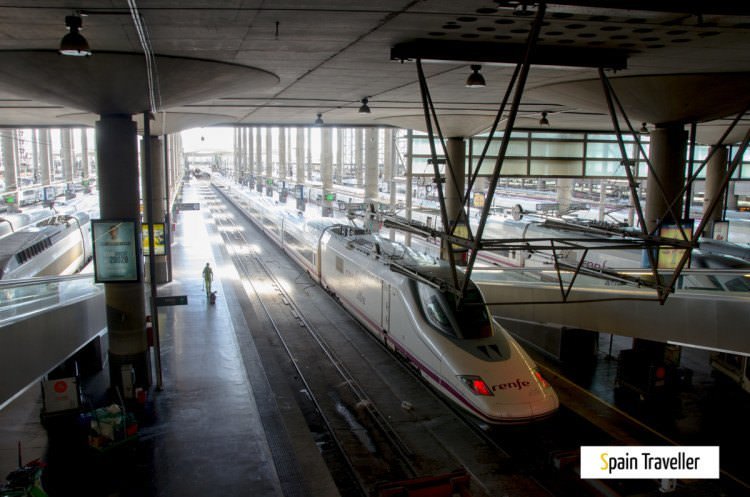
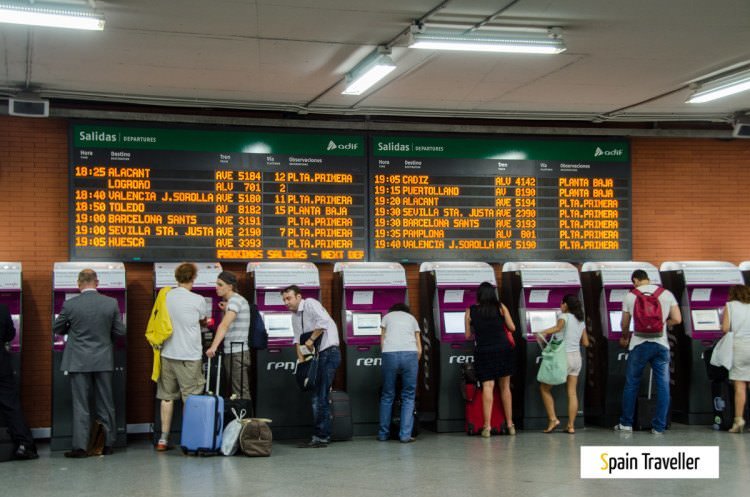
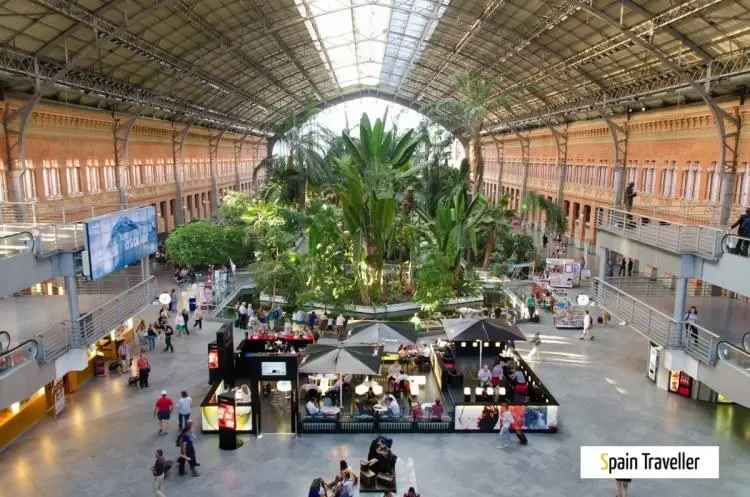

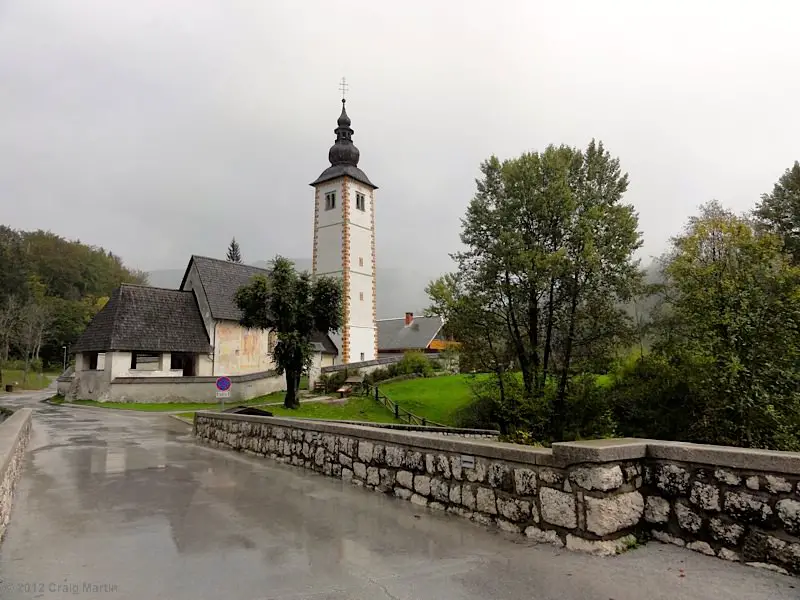



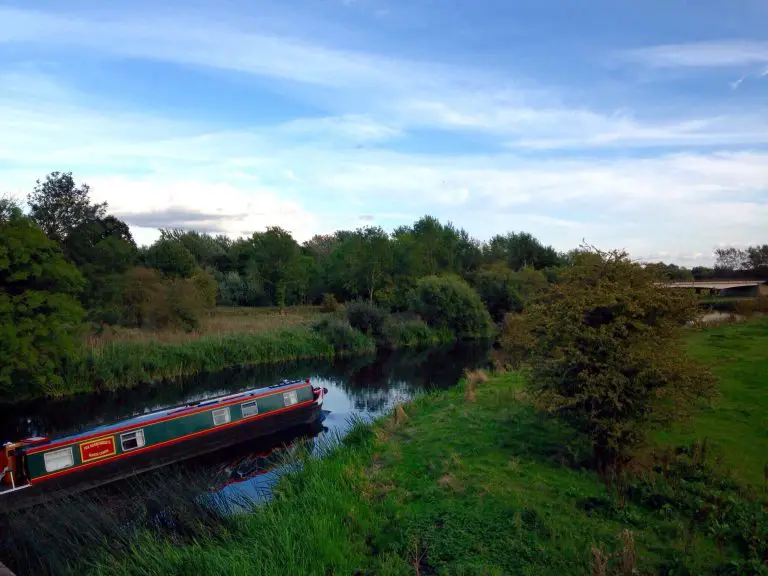
We love travelling by train, it’s in actual fact our favourite way of getting from A to B.
Whilst in Spain though we didn’t get the chance to use the train system, instead we used car sharing which is becoming a very popular way to travel in Europe. Have you tried it?
Hi Franca!
I do love traveling by train as well and it’s a shame you couldn’t use any of the Renfe trains and services because they work really well.
To answer your question, yes, I have tried car sharing and so far it has been a good experience (especially because it’s very cheap).
Thanks for your input!
wow the trains in Spain look so clean and luxurious compared to those i have travelled in before.. I keep looking up a working holiday visa for Spain so i can live for longer than three months hopefully this summer – thanks for the great blog posts and information its really helpful !
Yes, there are some older models still rolling, but the overall network is very modern.
Hi Jasmine, about 90% of the trains are relatively new and Renfe does a pretty good job in renewing the trains on a regular basis. Best of luck regarding your holiday working visa!
I don’t know what it is about trains but they just seem to make any trip more enjoyable.
I think it must have to do something with the old saying “its more about the journey then the destination.”
I agree, trains are extremely romantic… and much more comfortable than planes!
Obviously ..anyone want to travel wide area, then train is the best way and I love to travel by train.
The trains in Spain looks luxurious.
We’re planning our next two train trips right now 🙂 Valencia in April and Costa Brava in May.
Awesome! Let us know how they went.
Hey Sandra, we didn’t end up travelling by train as much as we would have liked during our stay in Spain, but we did make it to Valencia — by AVE. It was so fast! We were particularly happy to learn that we could get free Cercanias tickets to take us to the departure station in Madrid, so that saved us a bit of cash!
Whatever you do once your on a train in Spain or at the station, keep your personal belongings close to you. I had my bag (including passports) stolen from a station in Valenica. It was not a fun experience at all (understatement of the century). That’s my best piece of advice 😉
I am sorry about your negative experience Simon. Unfortunately, train stations in Spain have the same problem than in other places around the world, crowded places are perfect for pickpockets. That’s why no matter where you are, when you travel you should never leave your luggage and personal belongings unattended.
Hey guys, great article with some really useful tips! I’ve used trains in Spain a fews times, including an overnight service to Paris and couldn’t recommend it enough. You’ve really helped break down the rail pass issue too, which I’ve always found a bit confusing – thanks!
I am glad that you found the information useful. Let me know if I can help with something else… 🙂
Thanks, Very Interesting Information, i always like train travel……
Your information will help me at the time of traveling in Spain as on next month I am going to visit the place with my family.
I’m glad to hear it! Have a great trip.
Hello,
Myself and my partner are looking to travel Spain for a month from Bilbao to Madrid via Barcelona and Gibraltar, we are currently getting very mixed reviews on whether to purchase an Interrail.eu travel pass for 8 days, or the Renfe 8 day travel pass. Do you have any advice or recommendations on travel?
Thanks!
\joe
Hi Joe,
One of the main problems with using a rail pass in Spain is that almost all of the long-distance trains require a reservation, and these reservations can be very expensive. This is true whether you use the Interrail pass or the Renfe pass. I recommend you create an imaginary itinerary with the journeys you want to make, and check the reservation fees for each leg. If you don’t need to be flexible, you might find it cheaper to buy point-to-point train tickets in advance, and perhaps supplement them with shorter bus trips.